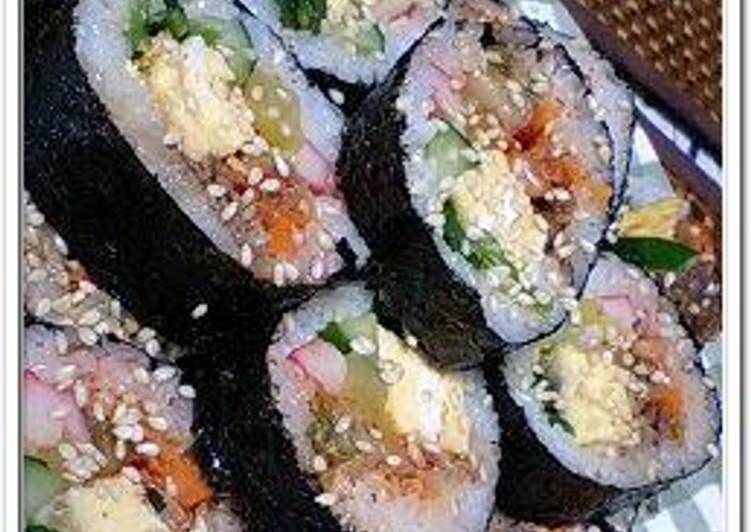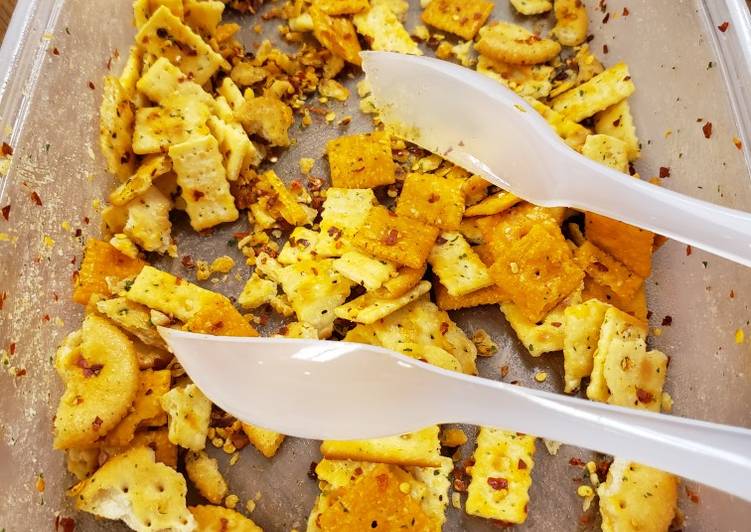
Hey everyone, I hope you’re having an amazing day today. Today, I’m gonna show you how to make a special dish, gimbap: korean nori seaweed rolls. It is one of my favorites. For mine, I’m gonna make it a bit tasty. This will be really delicious.
Gimbap: Korean Nori Seaweed Rolls is one of the most well liked of recent trending meals on earth. It’s enjoyed by millions every day. It is easy, it’s quick, it tastes delicious. Gimbap: Korean Nori Seaweed Rolls is something that I have loved my whole life. They’re fine and they look wonderful.
Gimbap (김밥) is a Korean seaweed rice roll filled with a variety of delicious fillings. Gim is dried sheets of seaweed, and bap means rice. We all grew up on these rice rolls. They were a must for our school field trips and outdoor activities as well as family road trips!
To begin with this particular recipe, we have to prepare a few components. You can have gimbap: korean nori seaweed rolls using 14 ingredients and 9 steps. Here is how you cook that.
The ingredients needed to make Gimbap: Korean Nori Seaweed Rolls:
- Take Plain rice (150 g per roll)
- Take ○ Sesame oil
- Make ready ○ Salt
- Make ready ○ White sesame seeds
- Get whole sheets Nori seaweed (Japanese type is OK)
- Get Fillings of your choice:
- Prepare Takuan (yellow dried and pickled daikon radish)
- Take Eggs
- Take Cucumber
- Take Carrot
- Prepare Spinach
- Take Fish sausage (or imitation crab sticks)
- Get Beef
- Take Kimchi
In my opinion, easy kimbap has more savory and subtle flavor than California roll. Gimbap (Kimbap) is Korean Rice Roll wrapped in seaweed much similar to a Sushi Roll. This recipe uses fresh cucumber instead of spinach, bulgogi seasoned. Learn the basics of these Korean-style seaweed and rice rolls and you'll be able to fill them with endless combinations of vegetables, meat, tofu, and Gimbap satisfies in many settings: as a light lunch for both adults and kids, as an easy-to-carry picnic and hiking snack, or even as a party appetizer.
Steps to make Gimbap: Korean Nori Seaweed Rolls:
- Mix the ○ ingredients into the rice. Alternatively, you can add the sesame oil and salt to the rice before cooking it, and add the sesame seeds to the cooked rice.
- Make the fillings ready. You can use whatever you like or have on hand. I made these with lots of filling. Cut the takuan pickles into 6-7 mm thick slices. Season the eggs with sugar and salt, make tamagoyaki (rolled omelette) and cut into 6 to 7 mm slices.
- De-seed the cucumber and slice lengthwise thinly. Cut the carrot into about the same size, boil then stir fry in a little oil, and season with a little salt. Blanch the spinach, refresh in cold water, squeeze out well and mix with a little sesame oil and salt.
- Cut the fish sausage into 6 to 7 mm thick pieces too. (If you're using crab sticks, split them in half lengthwise.) If you're using thinly sliced beef chop it up and stir fry it, and season with sugar and soy sauce or yakiniku sauce. You can use ground beef too. Squeeze out the kimchi lightly.
- Spread a sheet of nori seaweed as thinly as possible with rice. Be sure not to put any rice on the edges, which will overlap.
- Add the fillings, and roll up fairly loosely.
- When the rolls are made, brush the surfaces with a little sesame oil. Put some salt on your hands and spread it lightly over the surface too. Sprinkle on some sesame seeds to taste. If possible, keep them wrapped in plastic wrap for a while to allow the rolls to soften and meld.
- Cut into about 1 cm wide (rather thin) slices and they're done! Wipe your knife with a moistened kitchen towel while cutting in order to have nice looking slices. (This is a no-kimchi version.)
- This is a kimchi version. Kimchi and rice together is sooo good!
This recipe uses fresh cucumber instead of spinach, bulgogi seasoned. Learn the basics of these Korean-style seaweed and rice rolls and you'll be able to fill them with endless combinations of vegetables, meat, tofu, and Gimbap satisfies in many settings: as a light lunch for both adults and kids, as an easy-to-carry picnic and hiking snack, or even as a party appetizer. Kimbap is Korean Seaweed Rice Roll that is made with seasoned rice and various veggies and meat that's rolled in dried So some people think Kimbap or Gimbap is Korean version of a sushi roll because it uses the same bamboo mat and looks similar to. AT the end wrap the entire seaweed roll with bamboo roll and gently squeeze to secure. When all the seaweed rolls are completed into logs, put a little bit of sesame oil on your palm and rub the.
So that is going to wrap this up for this special food gimbap: korean nori seaweed rolls recipe. Thanks so much for reading. I’m confident that you can make this at home. There is gonna be more interesting food in home recipes coming up. Remember to bookmark this page in your browser, and share it to your loved ones, colleague and friends. Thanks again for reading. Go on get cooking!

